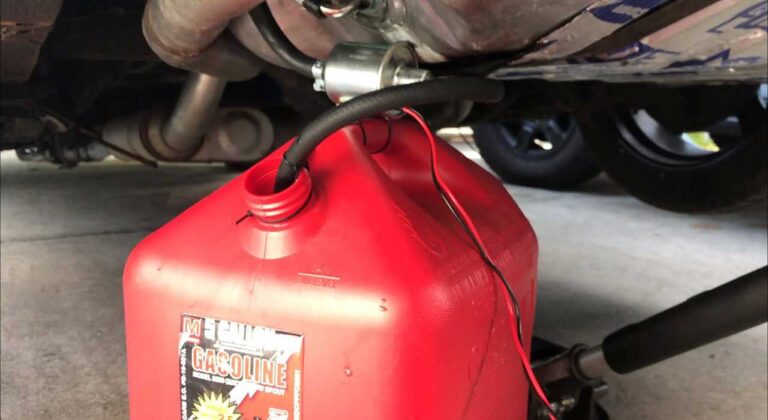
Method 1: Diphon The Fuel
-
- 1. Drive your vehicle to empty
If your car have the wrong gas in its tank, you should turn on the vehicle and then run it to empty. After that, park and let the car cool down before starting to drain the tank.
-
- 2. Buy a system of gas siphon
Easily found at most car shops, this system consists of manually run pumps which would take the fuel out of the tank and into the container. Remember to check it the model would work with flammable elements because any sparks in the fuel tank would definitely lead to serious disaster.
You should prepare an extinguisher in case the fire appears in the area.

-
- 3. Put the hosepipe into the fuel tank and feed it before pumping
This is probably the most difficult task of this process since a new model of car is often made with protected metal screen or bulb, which helps to keep fuel from getting away the vehicle if any crashes occur. For an old vehicle, you need to put the hosepipe in the tank correctly without obstacle.
-
- 4. Pump until the fuel comes out
When you are pumping, remember to prepare a container to contain the fuel. Hold to the end part of the hosepipe because it could move easily when the fuel starts to flow.If you do not use a pump, then you could do the same with a spare tube.
-
- 5. Take out the pump and refill the fuel tank
After the fuel tank is empty, your car would be ready to be repaired. If your diesel or gas car has a wrong gas put in a tank, then you might need to remove all of it and then refill with the proper type of gas.
-
- 6. Dispose or reuse the fuel correctly
If the fuel is not in bad or old condition, you could pump it into the tank of another car. If you want to get rid of the gas, then you would make a contact with the local environmental center to dispose it correctly. Never pour the fuel down a sewer or drain. In general, you could usually call the local department to get useful information on how to get rid of fuel effectively and safely.
If you are planning to reuse the gas after repairing the car, be sure that you are keeping the gas in an acceptable container. In addition, you might need to pay a sum of money to get rid of the fuel.
Method 2: Drain The Fuel With a Gas Pump
-
- 1. Understand that some gas tanks could not be directly drained
In fact, this is the standard of a car, but it probably does not work for some models. If you could find the gas tank under the vehicle and could directly remove the line or minor drain plug, then it is probably the simplest method to drain the tank of a vehicle.
-
- 2. Put a container or a pan under the tank
If your car have left a small amount of fuel in its tank, you should prepare to catch it. However, it is not really easy, so you need to measure how much fuel left in the tank before starting and use the suitable number of cans or containers.
-
- 3. Move under your vehicle car and look for the drainage point
In general, the gas tank is a solid and large container by metal at the same side of the vehicle when you are filling up the fuel. Use the fuel door, which is often under the seat on passenger side, to measure the drainage point. Also be sure that the pan is placed directly under this point.
-
- 4. Loose the screws at the drain point and allow the gas drain
In general, it would take you a long time, probably a couple of minutes each gallon. Therefore, you need to pay attention to it.
Remember to prepare the enough number of drain containers or pans so that you could catch all of the drained gas and make sure that no gas would be spilled into the ground.
-
- 5. Tightly fix the drain point and refill the fuel tank
Pay attention to putting the plug again correctly, particularly if the fuel lines are disconnected. After hooking up everything again, your car is ready to run.
I ordered a new fuel tank for my 1988 Chevy pick up and the new tank is missing the pan inside. I don’t know if the pan had a purpose that would allow me to eliminate it. I’m not sure if it is metal or plastic in the original tank and it is not secured so I don’t know if it was originally. It seems like it was intended to be directly under the fuel pump so it could prevent loss of fuel pickup while driving up steep inclines with low fuel levels and or just act as a baffle.
What is your take on this?
Thanks, Byron.